DAMA-DMBOK2
Framework
Patricia Cupoli
Susan Earley
Deborah Henderson
Editor
Production Editor
Program Director
March 6, 2014
©2012, 2013, 2014 DAMA International – All Rights Reserved
�
DAMA-DMBOK2 Framework
Table of Contents
1. About This Document ................................................................................................................. 2
1.1. Revision History .................................................................................................................. 4
2. What is the DAMA-DMBOK Guide? ........................................................................................ 5
3. Introduction to the DAMA-DMBOK2 Guide............................................................................. 6
3.1. History.................................................................................................................................. 6
3.2. Purpose of a Framework Outline ......................................................................................... 6
3.3. Purpose of the Guide ............................................................................................................ 6
3.4. Goals .................................................................................................................................... 7
3.5. Audience .............................................................................................................................. 7
3.6. Potential Uses....................................................................................................................... 8
4. Proposed Framework .................................................................................................................. 8
4.1. Knowledge Areas ................................................................................................................. 8
4.1.1. Context Diagrams ........................................................................................................... 10
4.1.2. Activity Groups ............................................................................................................... 13
4.1.3. Environmental Elements ................................................................................................. 13
5. DAMA-DMBOK2 Guide Structure .......................................................................................... 16
5.1. Outline................................................................................................................................ 16
5.2. Knowledge Area Chapter Structure ................................................................................... 25
6. Concordance between DAMA-DMBOK Guide Editions......................................................... 26
Table of Figures
Figure 1. The DAMA-DMBOK2 Guide Knowledge Area Wheel ................................................. 9
Figure 2. Knowledge Area Context Diagram Format ................................................................... 12
Figure 3. Environmental Elements ............................................................................................... 14
Figure 4. Environmental Elements – Scope Detail ....................................................................... 14
© 2012 DAMA International – All Rights Reserved
1
�
DAMA-DMBOK2 Framework
1. About This Document
This document describes the DAMA-DMBOK2 Framework published by DAMA International to
help formalize the best practices of our profession.
Deborah Henderson
DAMA-DMBOK2 Director
Past President, DAMA Foundation
Past VP Education Services, DAMA International
Patricia Cupoli
DAMA-DMBOK2 Editor
DAMA-ICCP Director
Past President: DAMA International, Chicago and Philadelphia Chapters
Susan Earley
DAMA-DMBOK2 Production Editor
DAMA Dictionary Editor
© 2012, 2013, 2014 DAMA International – All Rights Reserved
2
�
DAMA-DMBOK2 Framework
DAMA-DMBOK2 Guide Project Committee Members
Patricia Cupoli
Editor
Susan Earley
Production Editor
Deborah Henderson
Program Director
Sanjay Shirude
DAMA International VP Education
Eva Smith
Project Infrastructure Manager
Elena Sykora
Bibliographic Editor
Emarie Pope
Framework Assistant
© 2012, 2013, 2014 DAMA International – All Rights Reserved
3
�
DAMA-DMBOK2 Framework
1.1. Revision History
Version Date
.1
Description
Restructured functions from 10 to 14, corrected meta
data to metadata
Revisions to Functional Wheel Scope and associated
text.
Revisions to document organization and new sections
written
General Revisions
General Revisions, merge multiple versions
Comments to resolve between multiple versions and
added LinkedIn comments
New context diagram and text updates, reordering of
sections
General revisions
Further refinement of document structure, new
images, moved all references to changes from
DMBOK 1 to end, added tables to show differences
between this framework and DAMA-DMBOK 1st
edition.
Edited document, added revised context diagram,
removed tables to be used in actual DMBOK.
Grammar, obvious errors, enhanced, questions re
”methods”, roles, regulations, owners, diagrams and
expanded some content outline . Added governance
to each KA
Revised diagrams.
Revised Section 5.2, expanded/corrected wording,
added comments for discussion. Deleted Section 4.2
and last paragraph in Section 7.
Revisions done within Google Docs and transferred to
this version.
Removed NEIMS – too USA centric
Commentary from review period
Went over Gordon Everest’s comments and finalized
Framework
Revised and updated according to editorial decisions
© 2012, 2013, 2014 DAMA International – All Rights Reserved
4
November 10,
2010
November 10,
2010
October 2011
October 2011
October 2011
November 2011
Author
Susan Earley
Robert Abate,
Susan Earley
Patricia Cupoli
Deborah
Henderson
Susan Earley
Patricia Cupoli
November 2011
Susan Earley
November 18 2011 Deborah
December 6, 2011
Henderson
Susan Earley
December 30,
2011 – January 3,
2012
March 4 2012
Patricia Cupoli
Deborah
Henderson
March 9, 2012
March 20-22, 2012
Susan Earley
Patricia Cupoli
14
March 24-25, 2012 DAMA-DMBOK2
April 23, 2012
July 29-September
4, 2012
Sept. 11, 2012
March 6 2014
Project
Committee
Patricia Cupoli
Susan Earley,
Deborah
Henderson
DAMA-DMBOK2
Project Team
DAMA-DMBOK2
Project Team
.2
.3
.4
.5
.6
.7
8
9
10
11
12
13
15
16
17
18
�
DAMA-DMBOK2 Framework
2. What is the DAMA-DMBOK Guide?
DAMA International’s Guide to the Data Management Body of Knowledge (DAMA-DMBOK
Guide) is a collection of processes and knowledge areas that are generally accepted as best
practices within the Data Management discipline. Data Management is an overarching term
that describes the processes used to plan, specify, enable, create, acquire, maintain, use,
archive, retrieve, control, and purge data. These processes overlap and interact within each
data management knowledge area (see section 4.1)
Data Management is vital to every organization. Whether known as Data Management, Data
Resource Management, or Enterprise Information Management, organizations increasingly
recognize that the data they possess is a valuable asset which must be managed properly to
ensure success. Businesses, governments, and other organizations are more effective when
they leverage their data assets.
Data Management is a maturing discipline. Data Management exists within a broader social
context, and a broader landscape of technology adoption and use, community, and
collaboration. Data Management concepts and supporting technology have evolved quickly
over the last thirty years, and continue to evolve.
Creating a formal, certified, recognized, and respected data management discipline is not an
easy task. The current environment can be a confusing combination of terms, methods, tools,
opinion, and hype. To mature this discipline, DAMA International’s Guide to the Data
Management Body of Knowledge (DAMA-DMBOK) provides concepts and capability maturity
models for the standardization of:
Activities, processes, and best practices
Roles and responsibilities
Deliverables and metrics
A maturity model
Standardization of data management disciplines will help data management professionals
perform more effectively and consistently. Executives, in particular, need to understand and
assign value to data management activities, in order to fully support, fund, and staff the data
management function. Moreover, standardization will also help us communicate with our
teammates, managers, and executives, and ubiquitous use will elevate Data Management into
a formal discipline around the world.
© 2012, 2013, 2014 DAMA International – All Rights Reserved
5
�
DAMA-DMBOK2 Framework
3. Introduction to the DAMA-DMBOK2 Guide
3.1. History
The DAMA Data Management Body of Knowledge (DAMA-DMBOK) has undergone an evolution
over the years. It began as the Guidelines for Implementing Data Resource Management in
1991. It was published by DAMA International in various forms through four versions in
collaboration with DAMA Chicago.
DAMA International published The DAMA Guide to the Data Management Body of Knowledge
(DAMA-DMBOK Guide, 1st edition) in 2009. The DAMA-DMBOK Guide was in development for
several years as a complete overhaul of the earlier Guidelines document. A Framework ‘white
paper’ was written and floated to the data management community for comment and input,
and became the basis for the first publication. Full DAMA-DMBOK Guide text development
proceeded with input from contributing authors, the DAMA-DMBOK Guide editors, DAMA-
DMBOK Guide Editorial Board, and over 120 DAMA member reviewers.
In preparation for the 2nd edition (hereafter referred to as DAMA-DMBOK2), input on existing
and proposed content has been collected from DAMA chapter members and Enterprise Data
World conference sessions.
The DAMA Dictionary of Data Management is now in its 2nd edition and was published in April
2011 containing almost 2000 terms, including terms from the DAMA Certified Data
Management Professional (CDMP) exams administered by the Institute for the Certification of
Computing Professionals (ICCP). It is aligned to the terms in the DAMA-DMBOK 1st edition and is
the glossary for the DAMA-DMBOK2 Guide.
3.2. Purpose of a Framework Outline
The Framework Outline for the Data Management Body of Knowledge 2nd edition (DAMA-
DMBOK2) described here aims to provide the proposed structure and outline of content for
organizing the second edition of the DAMA-DMBOK2 document. In order to ensure the work is
an accurate reflection of the profession, it is essential to gain community consensus for the
Framework that becomes the foundation of the document.
3.3. Purpose of the Guide
The DAMA-DMBOK2 Guide will continue the 1st edition philosophy of offering DAMA
standardization of Data Management guidelines, characteristics, and active practices. It will
cover the WHAT, WHO and WHY of Data Management and its various knowledge areas. It will
be modeled after other professional organizations’ Bodies of Knowledge (BOKs) such as PMI’s
PMBOK (Project Management BOK), and IEEE’s SWEBOK (Software Engineering BOK).
DAMA-DMBOK2 Guide expands the ‘environmental elements’ (section 4.2.3). The first edition
was more concerned with outlining the functions of data management. This edition will ‘close
© 2012, 2013, 2014 DAMA International – All Rights Reserved
6
�
DAMA-DMBOK2 Framework
the loop’. These elements, along with the context diagram and activity groups, describe the
data management processes and activities that are involved in a knowledge area.
The entire body of knowledge about data management is quite large and constantly growing.
The DAMA-DMBOK2 Guide is intended to provide a definitive introduction to that body of
knowledge. It presents a standard industry view of data management knowledge areas,
terminology, and common best practices, without going into implementation details. The
DAMA-DMBOK2 Guide introduces alternative views and industry accepted approaches where
clear differences of opinion exist.
The DAMA-DMBOK2 Guide should not be read as an attempt to be a complete authority on any
specific data management knowledge area. Instead, it points readers to widely recognized
publications, articles, and other resources for further reading on the HOW-TO methods and
implementation details. DAMA also encourages communities of practice discussions on the
topics presented.
3.4. Goals
The goals of the DAMA-DMBOK2 Guide are:
1. To build consensus for a generally applicable view of data management knowledge areas.
2. To provide standard definitions for commonly used data management knowledge areas,
deliverables, roles, and other terminology, in conjunction with the DAMA Dictionary of Data
Management, and thus, to move the Data Management Community towards
standardization on concepts and activities.
3. To identify guiding principles for data management.
4. To clarify the scope and boundaries of data management activities.
5. To provide an overview of commonly accepted good practices, widely adopted techniques,
and significant alternative approaches, without reference to specific technology vendors or
their products.
6. To provide common organizational and cultural issues.
7. To identify strategies for data management maturity analysis.
8. To provide additional resources and reference material for further understanding of data
management.
3.5. Audience
The audiences for DAMA-DMBOK2 Guide will be similar to the audiences for the 1st edition
including:
Certified and aspiring data management professionals.
Other Information Technology (IT) professionals working with data management
professionals.
Data stewards at all levels.
Executives with an interest in managing data as an enterprise asset.
© 2012, 2013, 2014 DAMA International – All Rights Reserved
7
�
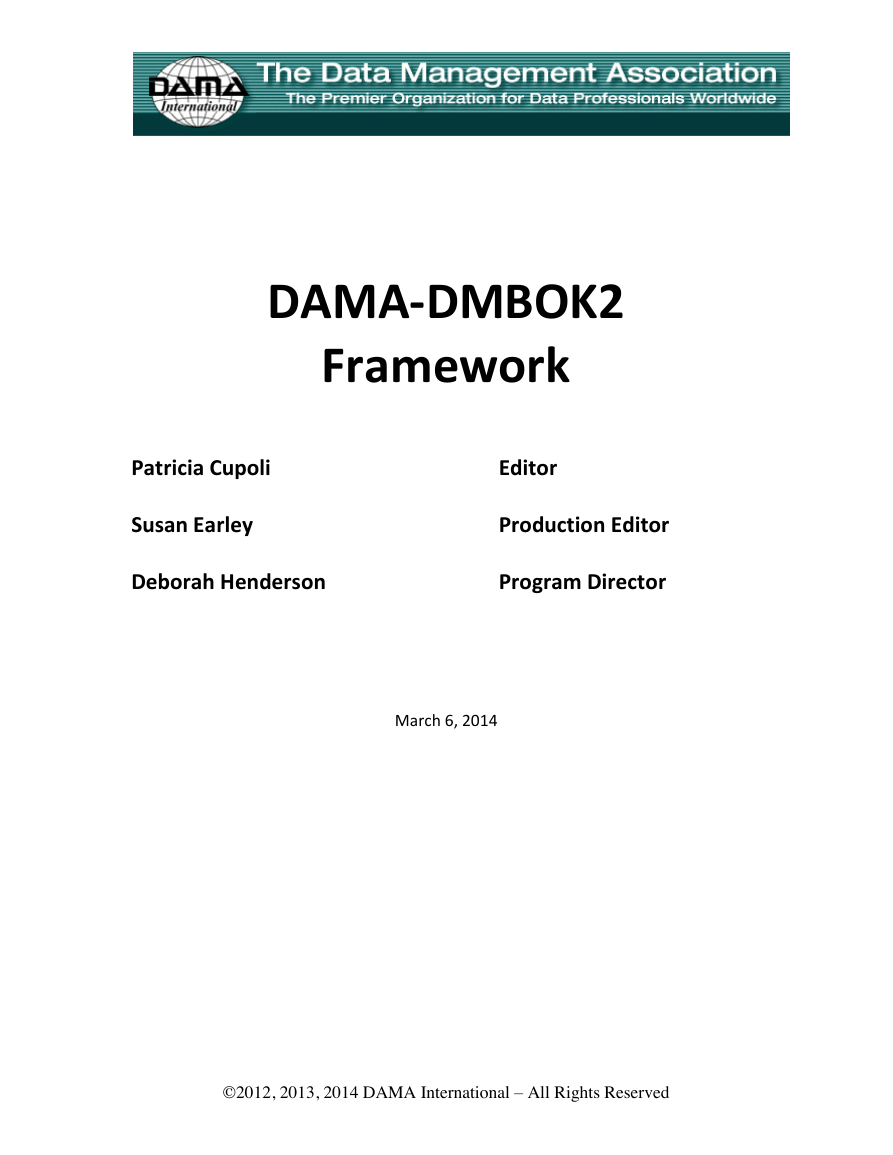
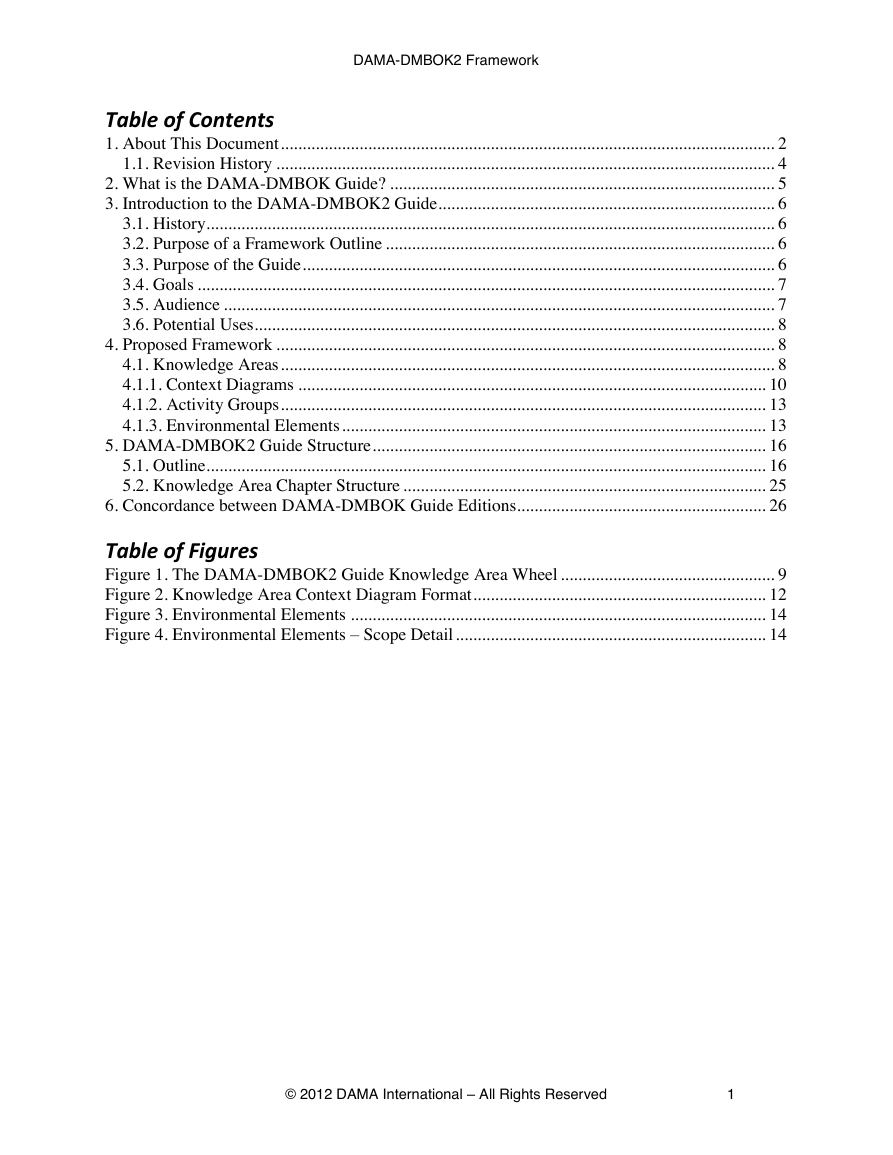
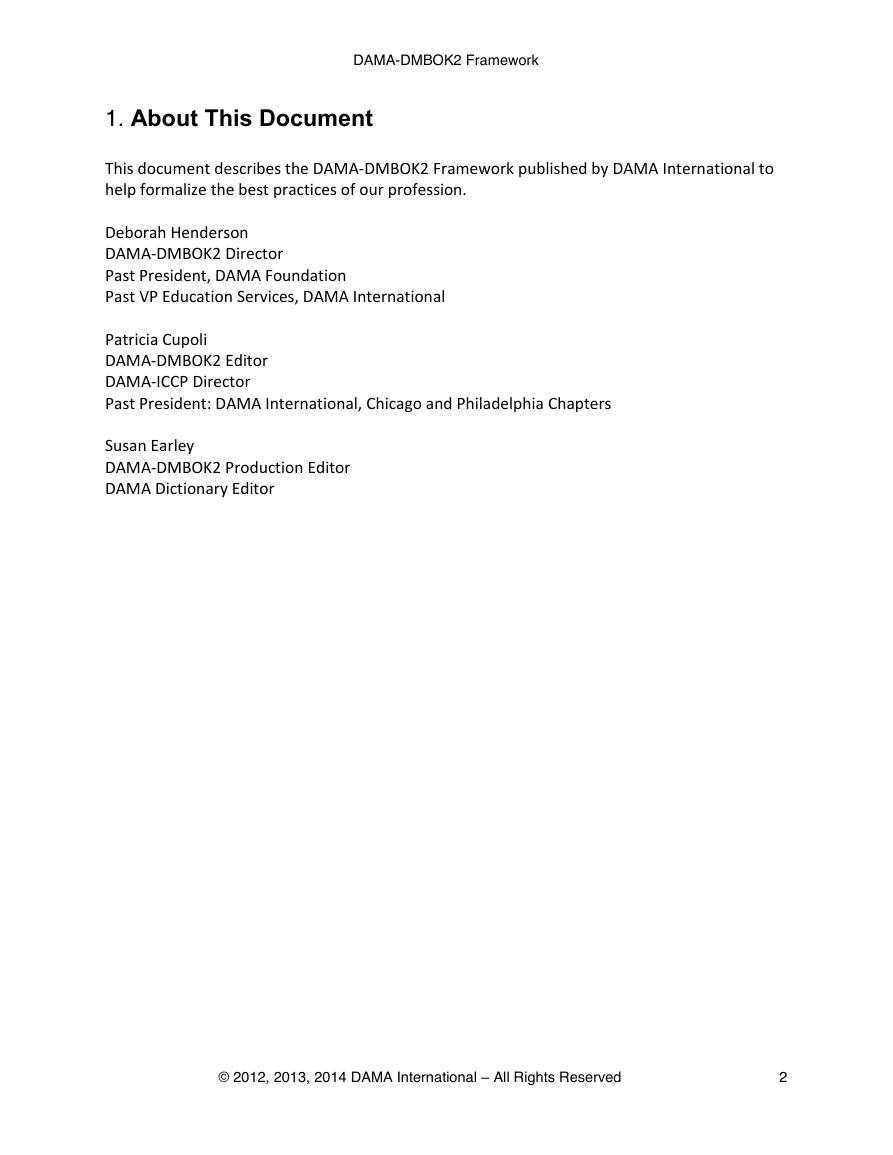
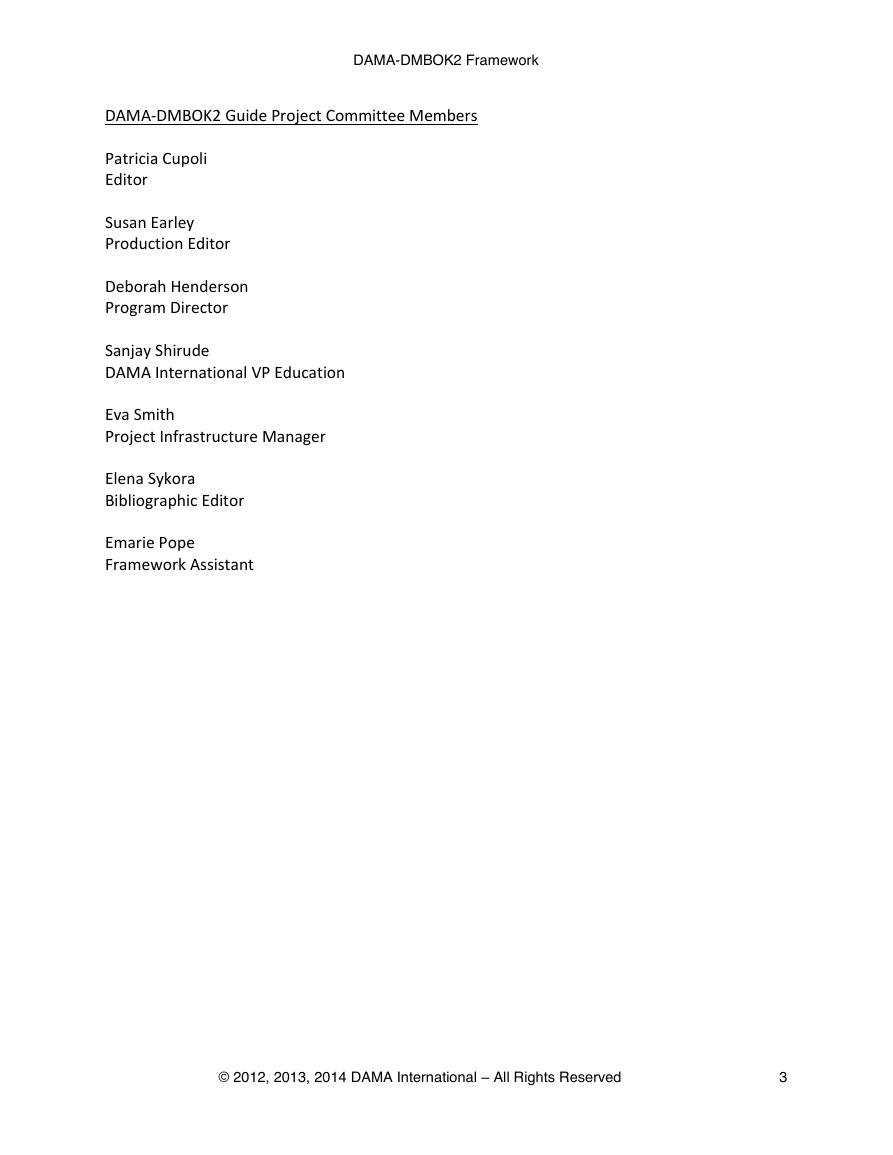
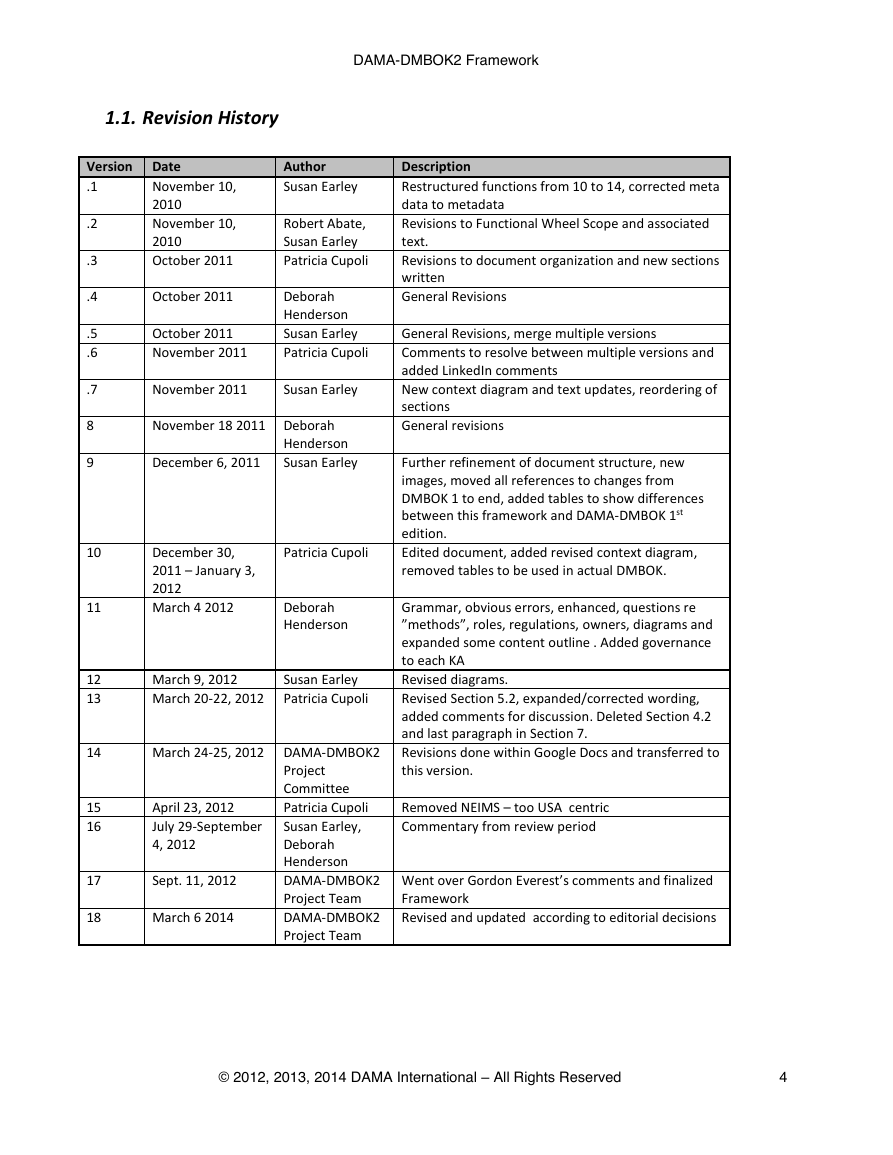
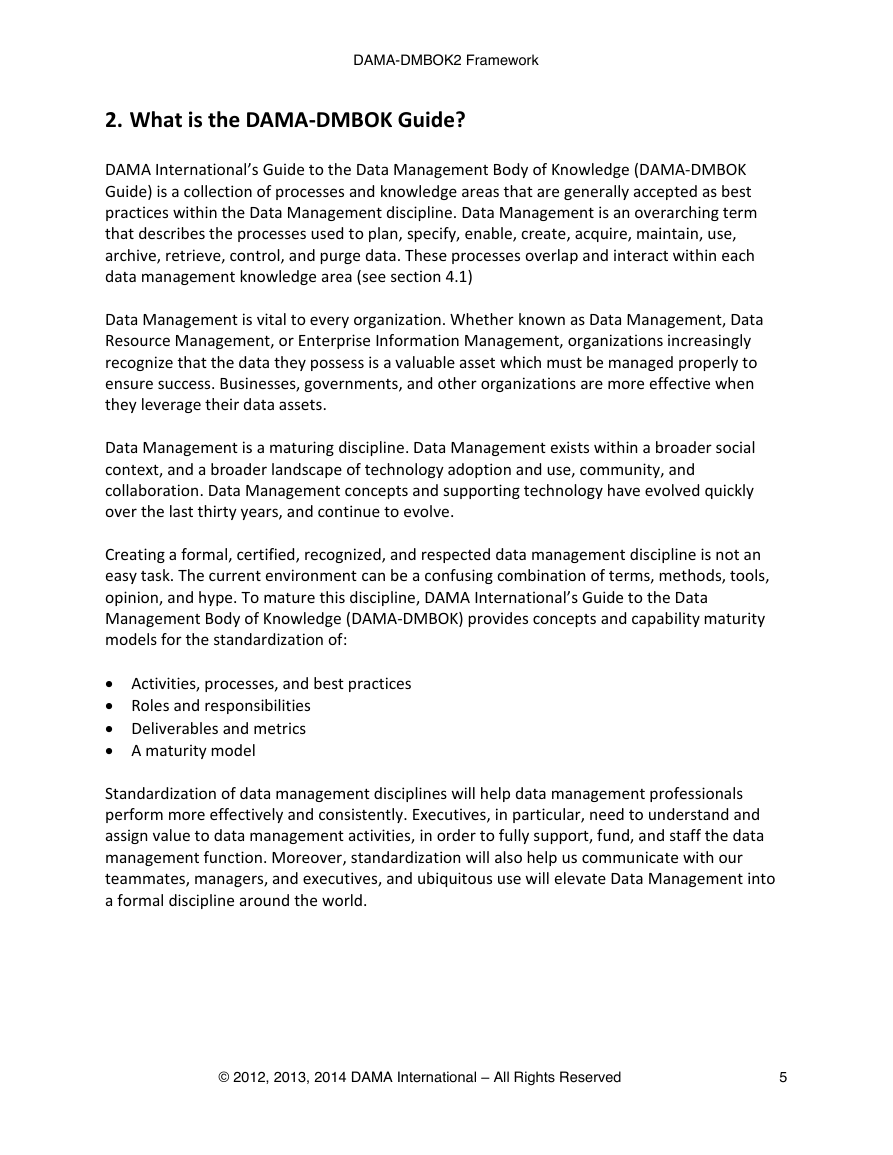

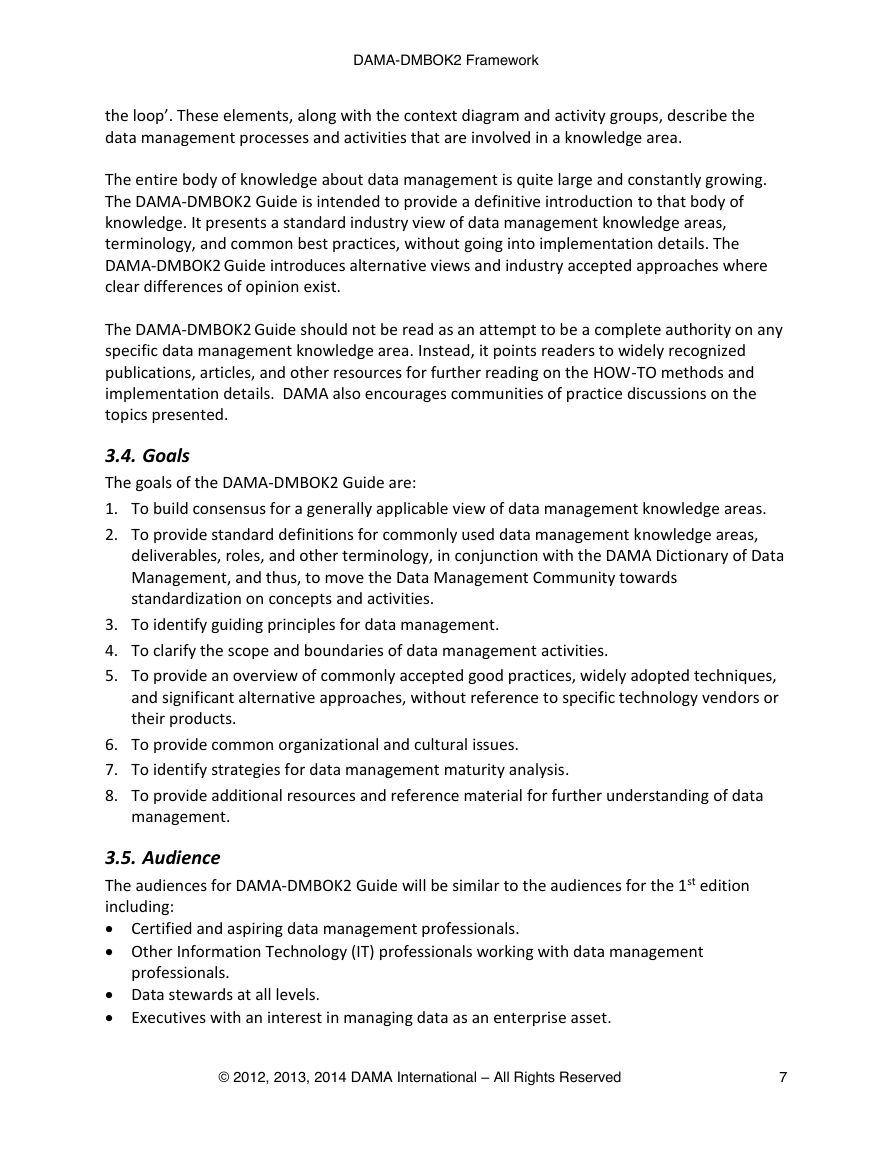








 2023年江西萍乡中考道德与法治真题及答案.doc
2023年江西萍乡中考道德与法治真题及答案.doc 2012年重庆南川中考生物真题及答案.doc
2012年重庆南川中考生物真题及答案.doc 2013年江西师范大学地理学综合及文艺理论基础考研真题.doc
2013年江西师范大学地理学综合及文艺理论基础考研真题.doc 2020年四川甘孜小升初语文真题及答案I卷.doc
2020年四川甘孜小升初语文真题及答案I卷.doc 2020年注册岩土工程师专业基础考试真题及答案.doc
2020年注册岩土工程师专业基础考试真题及答案.doc 2023-2024学年福建省厦门市九年级上学期数学月考试题及答案.doc
2023-2024学年福建省厦门市九年级上学期数学月考试题及答案.doc 2021-2022学年辽宁省沈阳市大东区九年级上学期语文期末试题及答案.doc
2021-2022学年辽宁省沈阳市大东区九年级上学期语文期末试题及答案.doc 2022-2023学年北京东城区初三第一学期物理期末试卷及答案.doc
2022-2023学年北京东城区初三第一学期物理期末试卷及答案.doc 2018上半年江西教师资格初中地理学科知识与教学能力真题及答案.doc
2018上半年江西教师资格初中地理学科知识与教学能力真题及答案.doc 2012年河北国家公务员申论考试真题及答案-省级.doc
2012年河北国家公务员申论考试真题及答案-省级.doc 2020-2021学年江苏省扬州市江都区邵樊片九年级上学期数学第一次质量检测试题及答案.doc
2020-2021学年江苏省扬州市江都区邵樊片九年级上学期数学第一次质量检测试题及答案.doc 2022下半年黑龙江教师资格证中学综合素质真题及答案.doc
2022下半年黑龙江教师资格证中学综合素质真题及答案.doc